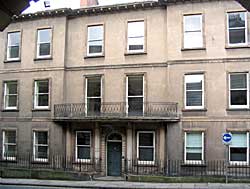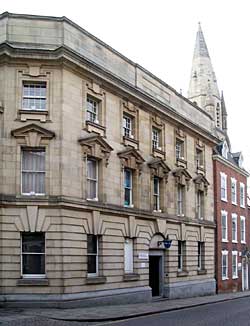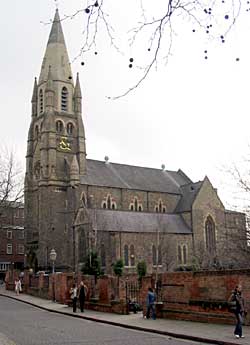< Previous | Contents | Next >
High Pavement
 County House on High Pavement (A Nicholson,
2004).
County House on High Pavement (A Nicholson,
2004).The two houses numbered 17 and 19, High Pavement, have leaden rain water heads with the initials S F. M. and they date from 1731. The house was erected in that year by Samuel and Mary Fellows, the representative of a house of no small importance in Nottingham's history. The founder of the family was Samuel Fellows, who sometime about 1700 was apprenticed to one John Howitt, who was a frame-work knitter. He prospered in business, and afterwards became an Alderman and finally Mayor of Nottingham. His son, John Fellows, continued the business and followed in his father's civic footsteps, being afterwards an Alderman and three times Mayor of the town. John Fellows still further increased the business, which was situated in Broad Marsh, and moved from this old house to the County House, No. 23, High Pavement. In 1808 he established the bank in Bridlesmith Gate, which many of us remember as Hart Fellows Bank, but his celebrity was eclipsed by that of his son Sir Charles Fellows. Sir Charles Fellows was a great antiquary and traveller. Between 1839 and 1841 he travelled in Asia Minor and, having discovered many treasures, he, in conjunction with the Trustees of the British Museum, shipped them to England, and they may still be seen in London. He published books on his travels and researches, and also upon ancient coinage, and for these various services he was knighted by Queen Victoria. He was also much occupied with the careful restorations of Carisbrooke Castle.
Mr. George Fellows, who was for so long the secretary of the Thoroton Society and whose writings are well known to local antiquaries, was the grand-nephew of Sir Charles Fellows, and it was under him that Messrs. Hart Fellows Bank was transferred to the great banking house of Lloyds.
The house is typical of the late 18th century construction with its crown glass windows, its tall narrow doorways surmounted by fan-lights and flanked by classic pilasters, and for a short time it was the residence of that strange character Henry Kirk White, the Nottingham poet, about whom everybody talks, but whose writings very few people read nowadays.

The former County Police Station on High Pavement (A Nicholson, 2004).
Almost opposite this old house are the modern buildings of the County Police Station, which occupy the site of the Castle Inn. This inn was probably a typical mediaeval hostelry built round a great yard and having galleries which formed passages by which the bedrooms could be reached, just as they do at the New Inn at Gloucester nowadays, and a curious story is told of this inn illustrative of the sordid and strange manners which obtained in the time of King Charles I. When King Charles came to Nottingham to raise his standard at the commencement of the great war between the King and the Parliament in 1642, he found Nottingham Castle so ruinous that it could provide no accommodation for him, and so he took up his residence in Thurland Hall in what we now call Pelham Street. Prince Rupert, his dashing cavalry leader, quartered himself at this Castle Inn, and when he arrived at his quarters he called for a bottle of wine, the drawer or waiter brought it to him, and, in accordance with the custom of the times to guard against poison, he was instructed by the Prince to drink the first glass. This he refused to do and the Prince's suspicions were immediately aroused, and drawing his sword he made a rush at the unfortunate man, who only escaped instant death by vaulting over the banisters of the gallery outside the room into the great yard below. The landlord came rushing up and succeeded in pacifying Prince Rupert by explaining to him that the man meant no disrespect or harm to the prince, but that he was a strict teetotaler, but that he, the landlord, would be happy, if the Prince so desired, to attend upon him and drink the first glass out of every bottle which was supplied for the Royal consumption.
This inn must have disappeared soon after this event, for the land upon which it stood, and which is now occupied by police offices, was left open as a garden or vista, from which a magnificent view over the whole of the Leicestershire hills could be obtained from the windows of Mr. Fellows' house upon High Pavement.

The Unitarian Chapel at Weekday Cross is now a bar called the Pitcher & Piano (A Nicholson, 2004).
High Pavement Chapel, as we know it at present, was built in 1876, but its history as a place of worship goes back several hundred years, and behind the present building are some interesting remains of an old building. In 1651 the Rev. John Whitlock occupied the office of Vicar of St. Mary's. Of course, this office was not quite the same as it is nowadays, for in those days, during the ascendency of the Puritan Party in England, another form of worship than that of the Established Church obtained. But at any rate Mr. Whitlock was the chief minister of the church, and appears to have been an exceedingly holy and acceptable minister. He was assisted in his work by Mr. William Reynolds, his bosom friend, who acted as lecturer, and they carried on very fine work in the church until after the Restoration. In 1662, for political reasons, an Act of Parliament was introduced called the Act of Uniformity, which provided that all clergy should accept a declaration of certain forms of church government and of theology so that the whole religion of the land should be of a uniform character. In common with many other able and devout clergymen Mr. Whitlock and Mr. Reynolds found that they could not conscientiously conform to this Act, and so they became nonconformists and consequently were not allowed to continue their ministry in St. Mary's Church. The Rev. John Barratt, who was minister of St. Peter's Church, found himself in a similar plight, and as they were all three destitute of means of subsistance they were hospitably entertained by Sir John Musters at Colwick Hall. Their troubles were not at an end, for in 1666 a further Act of Parliament made it a penal offence for a minister to reside within five miles of the church at which he had officiated, so these three divines removed to Shirebrook and afterwards to Mansfield. But so true were they to their congregation that arrangements were made for them to visit Nottingham by stealth, and I think that probably the authorities winked at these visits. They had various places of meeting, but the most important were in the huge rock cellars underneath Vault Hall, the house which stood at the corner of Drury Hill and Low Pavement. Part of James II.'s policy by which he hoped to re-introduce Roman Catholicism was to tolerate all forms of religion, and so in 1687 these three worthy clergymen were enabled to return to Nottingham, and in 1687 a congregation assembled under their guidance in a house in St. Mary's Gate, whose site, I believe, is now lost. This congregation was of such importance that in 1690 a chapel was built in High Pavement, more or less on the site of the present building, which was supported by nearly all the great families of Nottingham from the Earls of Clare downwards. It is very pleasing to know that after Mr. Reynolds's death, by an act of large-heartedness his body was buried in St. Mary's Church, and the blue tombstone which covers his remains acts partially as a foundation for the pulpit which is occupied week by week by the Vicar of St. Mary's Church. The place of worship thus established, flourished exceedingly; it was nick-named "Little St. Mary's," and it was attended by many of the great families. Byron, the poet, was regularly brought here as a boy, and it is interesting to remember that the greatest of Nottingham artists, Richard Parkes Bonnington, was baptised within its walls. In 1815 great alterations and improvements were made to the fabric, and the foundation was laid of a very valuable library in connection with the church. In 1815 an organ was placed within its walls, but finally, as we have said, in 1876 the present building took the place of the older edifice. It is well worth entering, for apart from its strange and beautiful memories the south window is enriched with magnificent modern stained glass, designed by Burne-Jones and executed by Holiday, and its extraordinary pulpit is also worth consideration.
